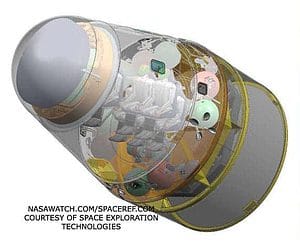
The Dragon capsule, a reusable spacecraft developed by SpaceX, set to dock with the International Space Station in a forthcoming launch.
You might have thought I made a typo and that I was probably meaning to say $500 million, but truth be told I’m only citing SpaceX founder Elon Musk word for word, and while most of you might view the man insane, what great visionary wasn’t cast under the same shadow in the beginning, only to be hailed as a savior or hero by society? The entrepreneur’s company, SpaceX, is one of the leading players in the private space flight industry and is currently prepping for the first private flight visit to the International Space Station.
Musk, founder of PayPal and Tesla Motors among others, is a brilliant CEO and entrepreneur by a all means, however isn’t he a bit too confident? Well, he argues that technology is advancing at an ever rapid pace, and with it brings a lower space flight cost, to the point where any man, not just astronauts, could set on voyages as far as the red planet in the future. The secret? Reusability – the more a spacecraft can be used without having to replace parts or auxiliary components, the cheaper the whole flight will be. Ideally, the only item in a mission that should need replacing is the fuel.
“My vision is for a fully reusable rocket transport system between Earth and Mars that is able to re-fuel on Mars – this is very important – so you don’t have to carry the return fuel when you go there,” he said.
“The whole system [must be] reusable – nothing is thrown away. That’s very important because then you’re just down to the cost of the propellant.
“We will probably unveil the overall strategy later this year in a little more detail, but I’m quite confident that it could work and that ultimately we could offer a round trip to Mars that the average person could afford – let’s say the average person after they’ve made some savings.”
Musk claims that an advanced, reusable system could allow individuals seeking round trips to Mars for just $500,000, but only after the route has matured (you need a fueling station on the Mars side, else it won’t work) in around a decade – the maiden commercial flights will most likely cost even billionaires an arm and a leg. Musk believes that such a project might make its first steps in about 10 years, 15 at the worst.
To put things into perspective, NASA is currently collaborating with SpaceX for a much anticipated manned mission to Mars. Most of the elements involved in such a mission will likely be one-off, non-reusable, and not very likely to happen earlier than 2030.
For a man whose company, SpaceX, has only launched seven flights, three of which failed, Musk might came off to a lot of people as full of himself and on the hunt for some free publicity. Even so, NASA has great faith in him and SpaceX, which is why the agency is pushing Congress at the moment for more money in 2013 to seed the development of technology and flight systems at SpaceX. To sum up his idea, Musk said in a talk with the BBC that the easiest way to understand this very bold business plan is to take a look at the history of commercial airline travel.
“If you had to buy a new plane every time you flew somewhere, it would be incredibly expensive,” Musk says.
“A 747 costs something like $300m and you’d need two of them to do a round trip. And yet people aren’t paying half a billion dollars to fly from LA to London, and that’s because that 747 can be used tens of thousands of times.
“We must get to the same position in rocketry. That’s really what’s critical; in order to get a two orders of magnitude improvement beyond Falcon Heavy (in other words to get down to the $10 or $20 per pound to orbit range), you have to have high levels of reusability.
“You need to be in the position where it is the cost of the fuel that actually matters and not the cost of building the rocket in the first place.”









